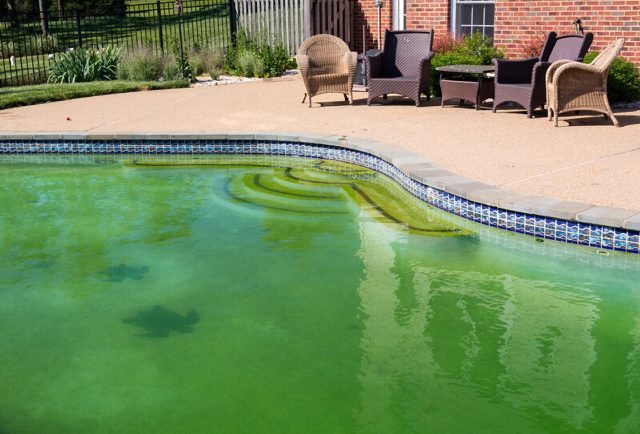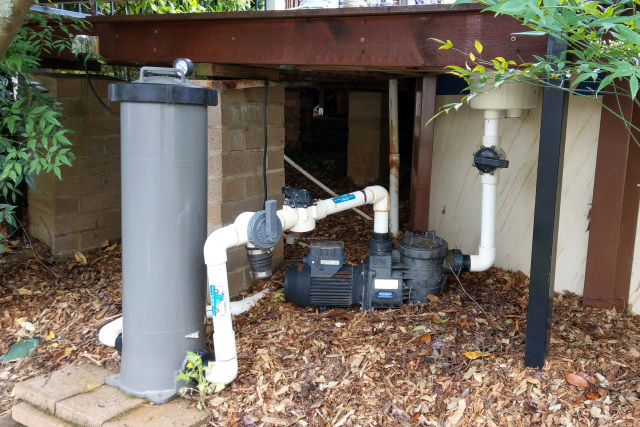Algae, though microscopic, can cause a variety of problems for your pool, ranging from clouding the water so to reducing perception, to producing carbon dioxide, which can raise the pH of the water.
One particularly detrimental consequence of having too many algae is that it can clog up your filter, a crucial instrument in preventing algae from forming or blooming. What should you do if algae are blocking your filter and stopping it from filtering?
If your filter isn’t filtering algae, it is likely blocked and will need to be cleaned. Sand and DE filters should be backwashed whilst cartridge filters can be hosed clean. To prevent future issues, the algae should be killed by shocking or super chlorinating your pool.
Since the filter is critical in removing microorganisms and debris from your pool, let’s first look at how the algae can block up the filter and how we can resolve this issue.

Article Contents
Does Algae Block Up Pool Filters?
There are 3 types of filters commonly used in pools (cartridge, sand, and diatomaceous earth (DE)). Because each filter works a different way, some block up with algae faster than others.
- Cartridge filter – Remove the cartridge from the filter, clean it with either water or a filter cleaner, and place it back into the filter.
- Sand filter – Backwash and use sand filter cleaner via the pump.
- DE filter – Backwash, remove and clean the grids in the manifold.
At the end of the day, they all perform the same function, which is to keep your pool water clean by removing dirt, debris, and (occasionally) bacteria.
The water is first pulled out of the pool via the skimmers and drain (if you have one) on the pool walls and floor respectively. The water is then pumped to the filter via the pool pump.
After the water is cleaned by the filter, it flows down the plumbing to either the heater or salt chlorine generator (if you have either of these) before it’s returned to the pool via the return jets on the pool walls.
The quality of the filtering depends on its “micron level”, meaning the size of debris it can filter out. The smaller the micron level, the better the filter is as it can remove smaller debris from the water.
Having an algae outbreak in your pool means in all likely hood, your filter will block up or clog very quickly.
Algae can spread very fast if left without treatment. And if this happens there will be a lot of organic matter in the water which the filter needs to remove.
Whether you’ve just killed the algae by shocking your pool or super chlorinating it, or you have live algae, pool filters will block up quickly, sometimes within minutes or hours when you have algae.
How Do You Know if Algae is Clogging the Filter?
If you’re ever in doubt whether you have an algae problem, look out for these signs:
- Green tint to the pool water.
- You can see green, yellow or black patches in the pool.
- Your free chlorine (FC) drops quickly (sometimes overnight).
- You have little or no chlorine in the water i.e. <1 ppm.
- You’re getting repeated clogging of your filter, even after cleaning or backwashing.
- You’ve opened your filter and can see green (algae) inside it.
If so, then you most likely have an algae bloom.
Algae bloom is often the main culprit when it comes to your pool filter clogging up. When there’s not enough chlorine in the water to kill off the algae completely, you can easily have algae coming into and filling up your filter.
Another possibility is you have dead algae that were simply gathered up by the filter. This shouldn’t be an issue in the future. Dead algae look grey in color.
Does Algae Block All Filters?
Now, let’s take a look at the specific types of filters, including how each one works, in detail.
Cartridge Filter
A cartridge filter is probably the easiest filter to be clogged. When you have an algae bloom, the algae can easily become trapped in the polyester cloth or paper inside the filter. After the algae are killed, the dead algae can also quickly fill up the cartridges.
Cartridge filters use sheets of polyester cloth or paper that are folded over themselves as the medium to catch and trap debris. These filters can either have one large cartridge, or several smaller cartridges contained within one device.
These filters can filter particles no smaller than 40 microns.
Because a cartridge filter filters out both larger and smaller debris, it can collect not only algae but other oils and minerals in the water as well. Hence, if you have one, you might find your cartridge filter clogging up very quickly due to a multitude of factors.
Sand Filter
On the other hand, a sand filter is the least likely to be clogged by algae. Because sand filters use only sand to filter out rather large debris, it’ll take a while before they become clogged with tiny particles like algae.
A sand filter is merely a filter filled with sand. Slotted lateral pipes along the filter help disperse water within the filter to ensure water completely washes over the sand, thus allowing the sand to capture as much debris as possible.
A sand filter has the lowest filtration capacity of the three filtration types. They can only filter down to about 75 microns, hence they can leave behind debris observable by the naked eye.
DE Filter
Though DE filters probably won’t clog up in general as quickly as cartridge filters, they will be filled with algae the quickest of the three, due to their ability to filter out the smallest particles in the water via their grids.
Diatomaceous earth (DE) filters are a filter that uses 8-10 filter grids/fingers, which may look like stalactites or curved shutters, each filled with diatomaceous earth, a type of grounded up white sedimentary rock, to trap and remove debris.
The main benefit, and the reason why DE filters tend to be more expensive to purchase compared to something like a sand filter, is that the DE filters out the smallest particles of debris (only about 3 microns).
If you only have algae in your water, be prepared to clean your DE filter relatively quickly.
This is good news if you like having pristine clear water though as these filters clean the best. But it’ll probably cost you to spend excess time cleaning your filter if the chlorine hasn’t taken care of the algae.

Related Reading: Can You Downsize a Pool Pump?
What to Do if Your Filter Isn’t Filtering Algae
It’s common and completely normal for your filter to block up and clog quickly when you have lots of algae in your swimming pool.
So what should you do?
1. Kill the Algae
The first thing is to treat the pool for algae is dead. To do this, shock your pool or raise the chlorine levels. This is usually 2-5 times the standard amount of chlorine. That is, raise the levels to 7-15 ppm.
You’ll likely need to sustain this level of chlorine for a few days.
2. Filter the Water
Now you’ll need to continuously filter the water. You will need to run the pump 24 hours a day for several days. During this time, your filter may block up and clog many times. You’ll need to clean it when this happens.
Keep filtering and maintaining the high chlorine levels until the algae are dead.
The algae are dead if you can maintain the free chlorine level overnight without it dropping.
To do this, test the chlorine at night (when it’s dark). Note the level. Retest in the morning, as early as possible. Preferably before the sun comes up.
If the chlorine level hasn’t dropped much (only 1 or so ppm), the algae are dead.
3. Clean the Filter
Throughout this process, keep cleaning the filter. If you have a lot of algae, it will clog up constantly. Just stick with it. You may need to do this every couple of hours for a day or two.
4. Repeat Until Algae are Gone
Just keep maintaining the high chlorine level, and keep filtering and cleaning. Eventually, your filter will not block up and you’ll have clean water.
You will get through it though, I promise!
How to Clean Algae from Your Filter?
There are multiple ways to clean your pool filter. Though filters do similar work (they trap debris when water is pumped through), which cleaning method to use will depend on the type of filter.
Some will require you to apply chemicals (i.e. lubricants), while others might require backwashing.
Cartridge Filter
- Turn off the pump and filter system.
- Turn the air relief valve to release any excess air.
- Remove the clamps and remove the cartridge.
- Spray down the cartridge with your typical garden hose.
- Check the O-ring on the filter tank, and apply lubricant if it’s in good condition; otherwise, replace it.
- Rinse the cartridge and secure it back into the filter, closing the clamps afterward.
- Turn everything back on and open the air relief valve to release excess air.
Sand Filter
- Backwash the filter for 3-5 minutes (water will run the other way through your filter) to remove debris.
- Turn off the pump and turn the valve to the filter.
- Remove the pump lid, pour sand filter cleaner (details below) into the strainer basket, and replace the lid.
- Turn off the pump to leave the cleaner inside for roughly 8 hours.
- Backwash the filter again for 3 to 5 minutes.
- Turn the filter back on.
You can use a sand filter cleaner like this, which is only $24.99:
- Eliminates oils, minerals & gunk
- Improves backwashing process
- Safe to use with all types of sand filters
- Aids in backwashing by breaking down all contaminants and minerals
- Much cheaper alternative than changing the sand directly
- Not very effective if the sand is too contaminated
DE Filter
- Backwash for 3 to 5 minutes to remove debris.
- Turn the pump off and open the air relief valve.
- Remove the drain plug to allow water to leave the filter.
- Remove the clamps to remove the filter manifold and grids from the filter.
- Rinse the tank and flush out the debris from the grids by spraying with a garden hose.
- Place grids back into the filter tank.
- Recharge the filter with DE.
How Do You Kill Off the Remaining Algae, if Any?
Once you have killed off any remaining algae and filtered the water for a week, you may find your pool still looks cloudy.
This is algae the filter isn’t catching. To fix this, you can ensure that they’ve clumped together by using a flocculant. The flocculant will cause the dead algae to stick together and sink to the pool bottom.
You can then vacuum up the remains to ensure clear water. Make sure you vacuum to waste to avoid clogging the filter.
Related Reading: Using Muriatic Acid To Clear A Green Pool Quickly
Final Thoughts
Having your pool filter clogged up with algae can become messy and annoying. This guide should help you clean up your filter in no time, but you should always strive for prevention first.
Related Reading: Black Algae Dangers: How To Get Rid of It From Pool


